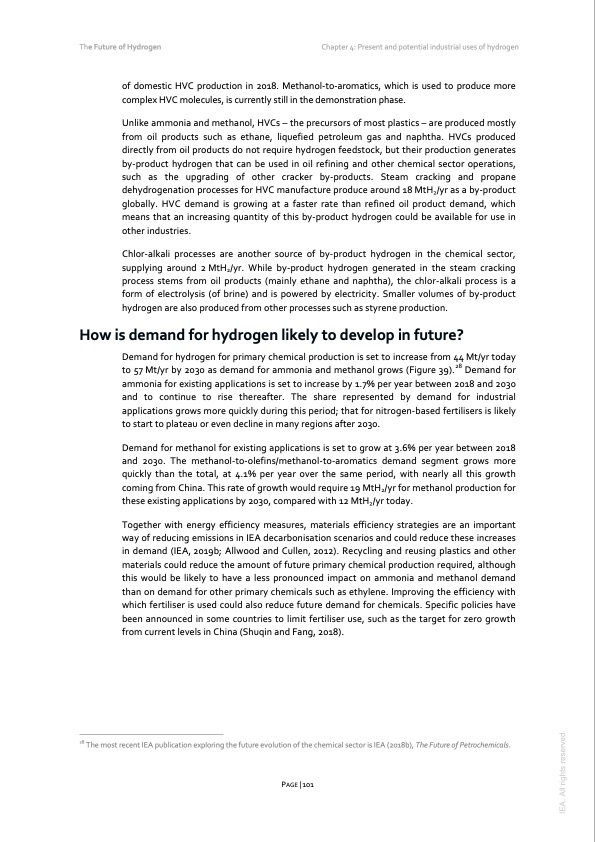
PDF Publication Title:
Text from PDF Page: 101
The Future of Hydrogen Chapter 4: Present and potential industrial uses of hydrogen of domestic HVC production in 2018. Methanol-to-aromatics, which is used to produce more complex HVC molecules, is currently still in the demonstration phase. Unlike ammonia and methanol, HVCs – the precursors of most plastics – are produced mostly from oil products such as ethane, liquefied petroleum gas and naphtha. HVCs produced directly from oil products do not require hydrogen feedstock, but their production generates by-product hydrogen that can be used in oil refining and other chemical sector operations, such as the upgrading of other cracker by-products. Steam cracking and propane dehydrogenation processes for HVC manufacture produce around 18 MtH2/yr as a by-product globally. HVC demand is growing at a faster rate than refined oil product demand, which means that an increasing quantity of this by-product hydrogen could be available for use in other industries. Chlor-alkali processes are another source of by-product hydrogen in the chemical sector, supplying around 2 MtH2/yr. While by-product hydrogen generated in the steam cracking process stems from oil products (mainly ethane and naphtha), the chlor-alkali process is a form of electrolysis (of brine) and is powered by electricity. Smaller volumes of by-product hydrogen are also produced from other processes such as styrene production. How is demand for hydrogen likely to develop in future? Demand for hydrogen for primary chemical production is set to increase from 44 Mt/yr today to 57 Mt/yr by 2030 as demand for ammonia and methanol grows (Figure 39).28 Demand for ammonia for existing applications is set to increase by 1.7% per year between 2018 and 2030 and to continue to rise thereafter. The share represented by demand for industrial applications grows more quickly during this period; that for nitrogen-based fertilisers is likely to start to plateau or even decline in many regions after 2030. Demand for methanol for existing applications is set to grow at 3.6% per year between 2018 and 2030. The methanol-to-olefins/methanol-to-aromatics demand segment grows more quickly than the total, at 4.1% per year over the same period, with nearly all this growth coming from China. This rate of growth would require 19 MtH2/yr for methanol production for these existing applications by 2030, compared with 12 MtH2/yr today. Together with energy efficiency measures, materials efficiency strategies are an important way of reducing emissions in IEA decarbonisation scenarios and could reduce these increases in demand (IEA, 2019b; Allwood and Cullen, 2012). Recycling and reusing plastics and other materials could reduce the amount of future primary chemical production required, although this would be likely to have a less pronounced impact on ammonia and methanol demand than on demand for other primary chemicals such as ethylene. Improving the efficiency with which fertiliser is used could also reduce future demand for chemicals. Specific policies have been announced in some countries to limit fertiliser use, such as the target for zero growth from current levels in China (Shuqin and Fang, 2018). 28 The most recent IEA publication exploring the future evolution of the chemical sector is IEA (2018b), The Future of Petrochemicals. PAGE | 101 IEA. All rights reserved.PDF Image | The Future of Hydrogen 2019

PDF Search Title:
The Future of Hydrogen 2019Original File Name Searched:
the_future_of_hydrogen.pdfDIY PDF Search: Google It | Yahoo | Bing
NFT (Non Fungible Token): Buy our tech, design, development or system NFT and become part of our tech NFT network... More Info
IT XR Project Redstone NFT Available for Sale: NFT for high tech turbine design with one part 3D printed counter-rotating energy turbine. Be part of the future with this NFT. Can be bought and sold but only one design NFT exists. Royalties go to the developer (Infinity) to keep enhancing design and applications... More Info
Infinity Turbine IT XR Project Redstone Design: NFT for sale... NFT for high tech turbine design with one part 3D printed counter-rotating energy turbine. Includes all rights to this turbine design, including license for Fluid Handling Block I and II for the turbine assembly and housing. The NFT includes the blueprints (cad/cam), revenue streams, and all future development of the IT XR Project Redstone... More Info
Infinity Turbine ROT Radial Outflow Turbine 24 Design and Worldwide Rights: NFT for sale... NFT for the ROT 24 energy turbine. Be part of the future with this NFT. This design can be bought and sold but only one design NFT exists. You may manufacture the unit, or get the revenues from its sale from Infinity Turbine. Royalties go to the developer (Infinity) to keep enhancing design and applications... More Info
Infinity Supercritical CO2 10 Liter Extractor Design and Worldwide Rights: The Infinity Supercritical 10L CO2 extractor is for botanical oil extraction, which is rich in terpenes and can produce shelf ready full spectrum oil. With over 5 years of development, this industry leader mature extractor machine has been sold since 2015 and is part of many profitable businesses. The process can also be used for electrowinning, e-waste recycling, and lithium battery recycling, gold mining electronic wastes, precious metals. CO2 can also be used in a reverse fuel cell with nafion to make a gas-to-liquids fuel, such as methanol, ethanol and butanol or ethylene. Supercritical CO2 has also been used for treating nafion to make it more effective catalyst. This NFT is for the purchase of worldwide rights which includes the design. More Info
NFT (Non Fungible Token): Buy our tech, design, development or system NFT and become part of our tech NFT network... More Info
Infinity Turbine Products: Special for this month, any plans are $10,000 for complete Cad/Cam blueprints. License is for one build. Try before you buy a production license. May pay by Bitcoin or other Crypto. Products Page... More Info
| CONTACT TEL: 608-238-6001 Email: greg@infinityturbine.com | RSS | AMP |